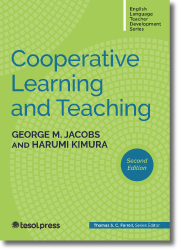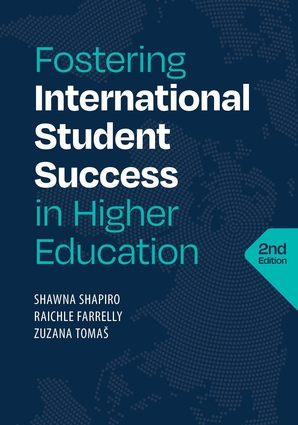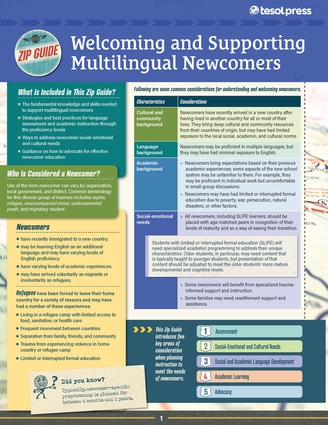Cooperative Learning and Teaching: Individual Accountability
by George M. Jacobs and Harumi Kimura
Are you looking for ways to help your multilingual learners of English work together more effectively and efficiently? The cooperative learning (CL) approach "combines a body of literature with each teacher’s and each class’s own experiences of, reflections on, and beliefs about what constitutes good education" (Jacobs & Kimura, 2024, p. 1).
 About This Book
About This Book
In the first edition of this book, Jacobs and Kimura provided a practical guide to CL in the English language classroom to help educators maximize the advantages of group activities. The second edition of Cooperative Learning and Teaching further explores the principles and techniques of cooperative learning and teaching. This edition adds four new chapters, shares new research, and suggests strategies for helping multilingual learners of English develop the cooperative skills needed to succeed in school and in life.
This essential guide will equip English language teachers with the knowledge to create fully functioning, effective, collaborative student groups that promote learning and motivate students to become lifelong learners. This book provides:
- Principles for cooperative teaching and learning
- Classroom activities and techniques to use with your students today
- Guidance for groupwork in virtual classrooms
The following excerpt is from Chapter 4, "Four Teaching Principles for Interaction" (pp. 25–26).
From the Book
Individual Accountability
What is wrong with this scenario?
A group is scheduled to make a presentation in class this afternoon. Yesterday, they discussed what each group member would do, and yesterday evening they were supposed to e-mail each other to share feedback on their parts. Unfortunately, Haryanto never e-mailed the other group members or replied to their e-mails, and this morning, when the others asked him what had happened, he told them he was busy playing a video game with some friends. He invited the others to play the game with him online tonight.
The CL principle of equal opportunity to participate attempts to give everyone a chance to take an active role in their group. Conversely, the CL principle of individual accountability seeks to encourage all members to make the most of that opportunity to participate and, thereby, share their ideas and energy with the group. In the story, Haryanto decided to use his ideas and energy elsewhere.
Among the ways that CL encourages each student to feel individual accountability to their group are the following:
-
Each group member takes a turn, such as in Circle of Speakers.
-
Each group member has a role to play, such as questioner (whose job is to ask questions), praiser (who highlights what group mates have done well), encourager (who encourages quieter members to take part in the group activities), and facilitator (who keeps the group on track toward completing their tasks).
-
After the group activity, everyone takes an individual quiz or does some other individual task, or the teacher calls on group members at random to present and explain their group’s ideas.
Technique: Everyone Can Explain
A CL technique that encourages individual accountability is Everyone Can Explain. The steps follow:
-
Groups work together on a task. Each student has a number, such as 1, 2, 3, or 4.
-
They develop a response(s) for that task.
-
They check that everyone in the group can give and explain the group’s ideas. (This is why the CL technique is called “Everyone Can Explain.”)
-
The teacher calls a number at random to explain what their group has done.
-
If classmates and the teacher like the answer, they praise the group mates for preparing the presenter well.
Purchase Cooperative Learning and Teaching from TESOL Press.
This excerpt is for educational use only. Not for reproduction.
©TESOL International Association (2024).
TESOL Blogs
Interested in writing a blog for TESOL?
Read the submission guidelines and send us your post!
Check out some of the most recent TESOL Blogs:
|
10 Tips for Hosting Successful PD Workshops, by Sarah Hodge

Professional development days are the perfect time to reconnect, learn, and share. Here are 10 tips for hosting successful workshops, even if you’re a first-time presenter. |
TESOL Bookstore

Featured Resources from TESOL Press
ELT Basics is an invaluable resource for those seeking a straightforward, practical, and foundational understanding of English language teaching. This book covers a broad range of important topics, such as what it means to “know” a language, how people learn new languages, and what teachers can do to teach English effectively. Whether you’re looking for a basic understanding of ELT or considering a career in language teaching but want to know more first, this book will teach you about language acquisition as well as how to plan, instruct, and assess multilingual learners of English.
 Fostering International Student Success in Higher Education, Second Edition
Fostering International Student Success in Higher Education, Second Edition
Shawna Shapiro, Raichle Farrelly, Zuzana Tomaš
(Copublished by TESOL and NAFSA)
The increase in the number of international students attending English-dominant schools brings benefits as well as challenges for institutions. Shapiro, Farrelly, and Tomaš provide a lively, informative discussion that answers the questions instructors commonly ask when seeking to ensure success for these students: What do I do to help students be successful in U.S. academic culture? How can I ensure that the content for my course is comprehensible to students who are still learning English? How do I design assignments and assessments that are fair while still acknowledging the difficulty of doing academic work in a second or foreign language? How might I treat international students as a linguistic and cultural asset in the classroom, and help them to become institutionally integrated?
 TESOL Zip Guide:
TESOL Zip Guide:
Welcoming and Supporting Multilingual Newcomers
Amber Warren, Melissa Hauke, Jan By Ying Hui-Michael, Adrienne Johnson
Newcomers are students who have recently immigrated to a new country, may be learning English as an additional language, and may have varying levels of English proficiency. This guide introduces five key areas of consideration when planning instruction to meet the unique social-emotional, linguistic, cultural, academic, and programming needs of multilingual learners of English who are newcomers. It includes strategies and best practices for language assessment and academic instruction through the proficiency levels, and guidance on how to advocate for effective newcomer education.